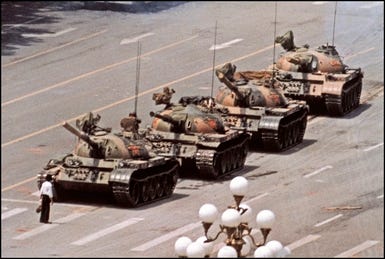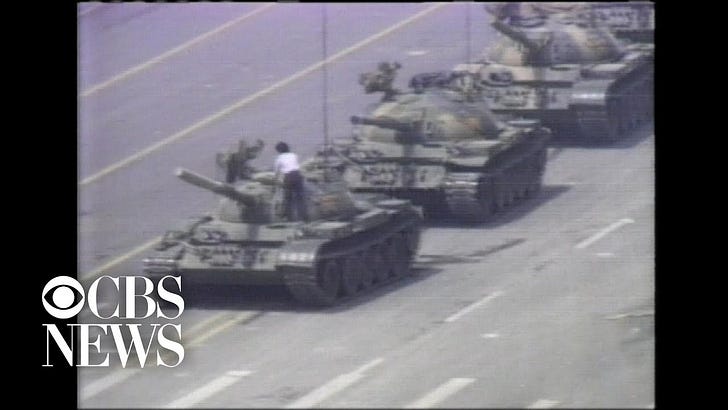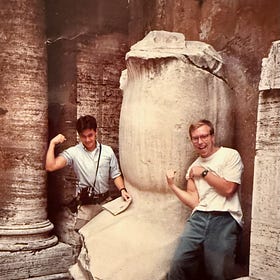
This is not the place for politics. There’s enough of that elsewhere — everywhere — and, sadly, most of us are so entrenched in our positions that we’re not going to reconsider anything anyway.
So this, I hope, is an apolitical post.
The above photo is one of the 100 most influential photos of all time, according to Time Magazine, which also named the man in the photo one of the 100 most important persons of the twentieth century.
He’s known as Tank Man. His identity has never been confirmed, though its been investigated for years. Some think he was executed six days later; some say he spent 20 years in prison and now lives in China; some suspect he escaped to Taiwan, where he works at a museum.
Because we don’t know who he is, we cannot know what drove him, the day after the Chinese government violently cleared Tiananmen Square of student protestors, to stand in front of a column of tanks, temporarily halting their progress.
But we can take an educated guess: things had gotten so bad in his country that he was willing to risk arrest — and in his case, execution. What was it that pushed him over the edge? We cannot know.
We can only ask: What would have to happen for me to stand in front of a tank?
A couple weeks ago, I wrote about our trip to Mississippi, specifically to the Mississippi Civil Rights Museum in Jackson.
History
I remember sitting in the courtyard of Fuller Theological Seminary, having lunch with Professor James Wm. “Jim” McClendon. He was semi-retired after a career teaching at the Graduate Theological Union in San Francisco, and had followed his spouse, Nancey Murphy, to Fuller, where he taught the occasional doctoral seminar. I had the good fortune of being invited into one of those seminars.
What stuck with me most from that incredible museum was the wall of black and white faces. These are the mugshots of those arrested in July, 1961. Most were Northerners who’d taken Greyhound buses south, to demand equal and integrated public accommodations for Blacks. As they exited the buses in Jackson, they were arrested and booked. Many of them spent weeks or months in Mississippi State Penitentiary, also known as Parchman Farm, where they responded to humiliation and degradation by singing hymns and spirituals.
The history of civil disobedience has a long and rich tradition in the U.S., and it includes everything from the Boston Tea Party in 1773 to the burning of draft cards 200 years later.
Since our visit to Jackson, I’ve been wondering if I would be one of those white faces on the wall. I’d like to think that had I been 25 in 1961, I would have boarded a bus and risked arrest. But there were about 2.8 million 25-year-olds in the U.S. that year, and only a few dozen ventured to Mississippi. That’s a statistically insignificant percentage of the population having a massively significant effect on society. Which, of course, is the entire point of civil disobedience.
Some days — no matter one’s politics — it seems like there’s a new issue each day that demands a response. You don’t have to watch much news to know that people are being provoked to attend congressional town hall meetings that a couple months ago they would have skipped. They’re picketing and marching. And, unfortunately, they’re engaging in the laziest form of activism: posting on social media.
But I’m talking about taking the next step. For what would I risk arrest? That’s the question I’ve been asking myself since we returned from Jackson.
And here’s the answer:




Each of these photos was taken in the Boundary Waters Canoe Area Wilderness, a place that I hold sacred and dear. Protection for the BWCA did not come easily. It came in stages throughout the twentieth century, culminating with the BWCA Wilderness Act of 1978. And to let you know how contentious that was: after his testimony in front of a congressional subcommittee, Sigurd Olson was hanged in effigy by his fellow residents of Ely, Minnesota.
Like many, I have taken the BWCA for granted during my adult life. I’ve given money to organizations that are fighting the ever-present threat of mining in the BWCA watershed. I’ve even gone to a couple pint nights for these orgs, and affixed their stickers to the back of my truck. But that’s been the extent of my activism on behalf of the BWCA: bumper-sticker activism. That’s because I’ve had the general sense that the BWCA is in safe hands.
I no longer think this. Without getting into the weeds of executive orders and competing pieces of legislation, I can tell you that the BWCA is currently under direct threat.
And if the bulldozers start to roll, you may see me standing in front of them.
Probably, it won’t come to that, so you won’t have the opportunity to call my bluff. And there’s no way to know if I’d actually do it unless the hypothetical becomes the reality. I get the sense from watching the video that Tank Man hadn’t planned his act for days. He made a spontaneous decision — he’s carrying bags full of groceries or laundry, fergodssake.
You may be thinking to yourself: With everything that’s happening in the world, that’s Tony’s most important issue?!?
I just hope your next question is: What am I willing to get arrested for?
Each of us has a Tiananmen Square.






Great piece. I'd stand right there with you on the Boundary Waters, as I'm sure so many others would.